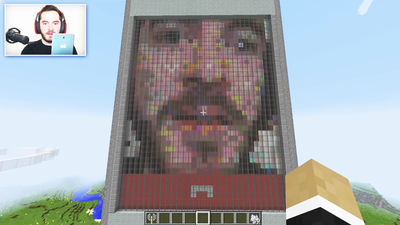A fierce man who spent six years creating 'the world's most impractical 1000 pixel wooden display' appears
While smartphone displays today have millions of pixels, allowing high-resolution images to be displayed instantly on a small screen, software engineer
I spent 6 years building a ridiculous wooden pixel display
https://benholmen.com/blog/kilopixel/
About six years ago, Holmen came up with the idea of creating a large, inefficient display with a web interface that anyone could use. He eventually came up with the idea of the world's most impractical display, a 40x25 grid of pixels rotated one by one by a single mechanism.
The proposed display would be 40x25 pixels, or 1000 pixels, so Holmen came up with the name ' Kilopixel .' He also acquired the domain ' kilopx.com ,' and began working on the project in earnest.
Holmen initially came up with the idea of using ping-pong balls or toy balls painted in half to act as pixels.
However, there were problems with the precision and processing of ping-pong balls, and there were also problems with the mechanism for rotating each ball individually.
In the end, Holmen decided to pixelate cubic wooden cubes instead of painted balls. Although Holmen had woodworking skills, it took a huge amount of time to make 1,000 wooden cubes, but he said he was satisfied with the final operability and appearance.
The wooden cubes Holmen created are shown below. Simply arranging the cubes at regular intervals on a thin shelf would result in large errors, so they were arranged by drilling holes in the shelf, threading metal wires through them, and precisely inserting the pixels into the holes. This was a painstaking process that took several weeks, but it resulted in a predictable pixel grid, allowing each pixel to move independently of the surrounding pixels.
The 40x25 pixel wooden display was beautiful just by arranging the wooden cubes, and various shapes and letters could be displayed by simply rotating them by hand. However, Holmen wasn't satisfied with this, so he connected a single-board computer, a Raspberry Pi, to a CNC (computer numerical control) controller and developed a device that extruded and rotated the appropriate pixels in response to API queries.
![]()
The wooden cube has notches every 90 degrees, which allows the pixels to line up correctly when extruded. The extrusion mechanism uses flexible
The ejector mechanism moves in front of the appropriate pixel in response to an API query.
As the glue stick is pushed out, the pixels rotate.
The color of the pixels changes as you rotate them.
The Kilopixel created by Holmen is installed in the office and draws shapes selected by vote from shapes submitted by users in real time.
kilopixel
You can see Kilopixel slowly drawing shapes in the archive of the live stream below.
Kilopixel - YouTube
The drawing of a certain shape begins at around 44 minutes and 48 seconds in the archive.
The pixels are flipped little by little, starting from the left, at a rate of 10 per minute.
At about
At around
Kilopixel's drawings are streamed live on YouTube.
Kilopixel:: one thousand pixels, one at a time - YouTube
In addition, users can use the drawing tool to apply for the design they want to draw with Kilopixel, and on the following page, users can vote for the design they want to draw from the designs collected from various users.
kilopixel
https://kilopx.com/submissions?ref=blog
Related Posts:
in Video, Hardware, Web Service, Science, Posted by log1h_ik







